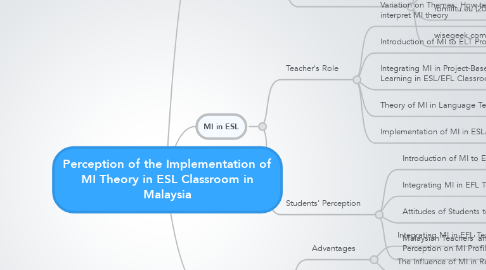
1. The Theory
1.1. 8 MIs
1.1.1. Jarvis&Parker (2005)
1.2. Naturalistic Intelligences
1.2.1. Cherry (2013)
1.3. Frames of Mind
1.3.1. Gardner (1983)
1.4. Naturalistic Intelligence
1.4.1. naturalist (2011)
1.5. MI in Teaching
1.5.1. Torresan (2010)
1.6. Educational Psychology
1.6.1. Fetsco. T & Mc Cure J (1995)
1.7. Existentialist Intelligence
1.7.1. Mark K, Smith (2008)
1.7.2. www.pbs.org (2013)
1.7.3. romilltu.eu (2014)
1.7.4. wisegeek.com (2014)
2. MI in ESL
2.1. Teacher's Role
2.1.1. Variation on Themes: How teachers interpret MI theory
2.1.1.1. Campbell (1997)
2.1.2. Introduction of MI to ELT Programmes
2.1.2.1. Altan (2012)
2.1.3. Integrating MI in Project-Based Learning in ESL/EFL Classroom
2.1.3.1. Bas (2008)
2.1.4. Theory of MI in Language Teaching
2.1.4.1. Torresan (2010)
2.1.5. Implementation of MI in ESL/EFL Classroom
2.1.5.1. Bas (2008)
2.2. Students' Perception
2.2.1. Introduction of MI to ELT Programmes
2.2.1.1. Altan (2012)
2.2.2. Integrating MI in EFL Teaching
2.2.2.1. Spirovska (2013)
2.2.3. Attitudes of Students towards Role-Play
2.2.3.1. Bora (2012)
2.2.4. Malaysian Teachers' and Students' Perception on MI Profiles
2.2.4.1. Zainuddin (2012)
3. Impacts of MI
3.1. Advantages
3.1.1. Integrating MI in EFL Teaching
3.1.1.1. Spirovska (2013)
3.1.2. The Influence of MI in Reading
3.1.2.1. Celik (2013)
3.2. Disadvantages
3.2.1. Integrating MI in EFL Teaching
3.2.1.1. Spirovska (2013)
3.2.2. Introduction of MI to ELT Programmes
3.2.2.1. Altan (2012)
3.2.3. Variation on Themes: How teachers interpret MI theory
3.2.3.1. Campbell (1997)

